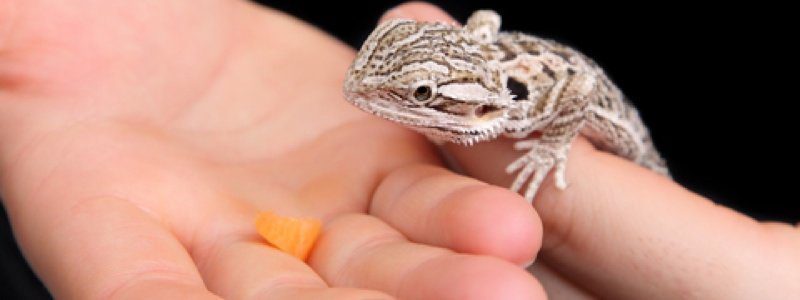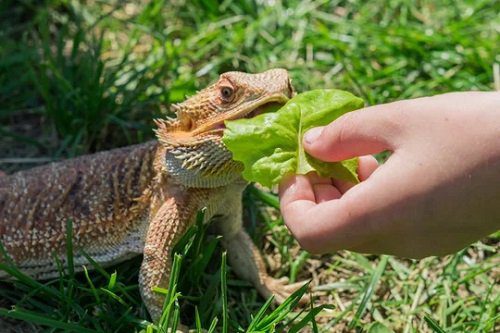Hand feeding can be a great way to bond with your bearded dragon. It allows them to associate you with food and comfort. With some patience and the proper technique, hand feeding can be easy and rewarding. Here’s a complete guide on how to hand feed a bearded dragon.
Bearded dragons are very responsive to hand feeding. By hand feeding 2-3 times a day, you can build trust and form a close connection with your dragon. Hand feeding allows the bearded dragon to see your hand as a source of food rather than a threat. It is especially important to hand feed baby and juvenile bearded dragons, as this will lead to better temperament as adults.
When starting, keep hand feeding sessions short (5-10 minutes). Make sure your dragon is alert and watching you. Go slowly and remain calm so you don’t startle them. With regular practice most beardies will become comfortable taking food from your hand.
Getting Started

Before you begin hand feeding, make sure your hands are clean to prevent spreading germs or illness. Wash your hands with soap and water. Avoid using scented soaps, lotions, or sunscreen on your hands before handling your dragon.
Gather some healthy feeder insects to offer. Crickets, mealworms, superworms, silkworms, and dubia roaches are excellent choices. Use metal feeding tweezers or tongs to initially pick up and present the prey. This prevents accidental bites as your dragon learns the hand feeding process.
Choose a familiar location to hand feed. The bearded dragon’s enclosure or a handling table work well. Make sure your dragon is alert and watching you as you offer food. Go slowly and don’t make sudden movements. Allow them to approach and take the feeder at their own pace.
Hand Feeding Technique

Follow these steps when hand feeding your bearded dragon:
- Hold the feeder insect by a back leg securely with tweezers or tongs. Wiggling prey items tend to trigger the feeding response.
- Slowly move the prey towards the front of the enclosure or right under your dragon’s face if hand feeding outside the tank.
- Once their eyes lock onto the prey, move it enticingly from side to side. Allow them to stretch towards it but don’t jerk it away.
- When they open their mouth in preparation to strike, release the insect and allow them to snatch and consume it.
- Offer praise and interact gently while they chew and swallow each piece. This reinforces the positive experience.
- Work up to presenting feeders balanced on your palm or grasping prey between your fingers. Letting them take food directly from your hand builds more trust.
Always start with tweezers/tongs and progress to direct hand feeding over many sessions. Every bearded dragon has a unique comfort level. Take cues from your individual animal. If they seem stressed, go back to using tongs for a while before trying hand feeding again.
Patience is key. Don’t be discouraged if your dragon isn’t receptive immediately. Consistency and short, positive sessions will achieve the best results over time. Monitoring their body language allows you to work at their pace.
Important Tips
Follow these tips to make hand feeding easier and safer:
- Supervise children closely when hand feeding to prevent rough handling.
- Avoid hand feeding if your dragon is in blue phase (opaque eyes/skin pre-shed). They cannot see prey well and may mistake fingers for food.
- Don’t attempt to hand feed if your dragon is stressed, intimidated, or aggressive. This can reinforce bad behavior.
- Always hand feed before free feeding. This teaches them to associate you with food.
- Try hand feeding 10-15 minutes before regular feedings so they are hungry but not starving.
- Offer an assortment of healthy feeders for variety like silkworms, crickets, small superworms, etc.
- Limit hand feeding sessions to 5-10 minutes max to prevent overeating or biting due to frustration.
- Wash hands before and after each session to prevent transferring bacteria from feeder insects.
- Monitor for signs of aggression like black beard, gaping mouth, hissing, whipping tail, etc. Stop the session if your dragon shows aggression.
With time and consistency, most bearded dragons will become comfortable hand feeding. It strengthens your mutual trust and is a great way to monitor their health. Pay close attention to their body language and go at their pace. Hand feeding provides fantastic enrichment when done properly.
Conclusion
Hand feeding allows bearded dragons to form a close bond with their owners. With the right technique and patience, most dragons will learn to take insects directly from your hand. Always start slowly with tongs and work up to fingers over multiple sessions. Monitor your bearded dragon’s signals to ensure they are comfortable. Hand feeding strengthens trust when sessions are positive, consistent, and kept brief. It is an extremely rewarding way to interact with these personable lizards.
FAQs About How to Hand Feed a Bearded Dragon
What types of food are suitable for hand feeding a bearded dragon?
Suitable foods for hand feeding a bearded dragon include gut-loaded insects like crickets, roaches, and mealworms, as well as leafy greens and vegetables. Ensure the insects are appropriately sized and dusted with calcium powder for nutritional balance.
What precautions should I take when hand feeding a bearded dragon?
To ensure safety, wash your hands thoroughly before and after handling your dragon and their food. Avoid overfeeding or offering foods that are too large to prevent choking hazards. Always supervise the feeding to monitor their behavior.
What should I do if my bearded dragon refuses to eat from my hand?
If your bearded dragon refuses food from your hand, it’s essential to respect their choice. Not all dragons may be comfortable with hand feeding. Continue offering food in their dish, and you can try hand feeding again later.
Are there any signs of stress or discomfort to watch for during hand feeding?
Signs of stress or discomfort during hand feeding may include agitation, hissing, puffing, or attempting to flee. If you notice these behaviors, it’s best to stop hand feeding and allow your dragon to eat from their dish.
Should I use any special tools or utensils for hand feeding my bearded dragon?
Feeding tweezers with blunt tips are useful tools for hand feeding bearded dragons. These tweezers allow for precise food presentation and minimize the risk of accidental injury during the feeding process.
How can I transition my bearded dragon from hand feeding to regular feeding methods?
Transitioning from hand feeding to regular feeding methods involves gradually reducing the frequency of hand feeding and offering food in their dish. Ensure the dish is easily accessible and contains a variety of appropriate foods to encourage independent feeding. Be patient during this transition.



